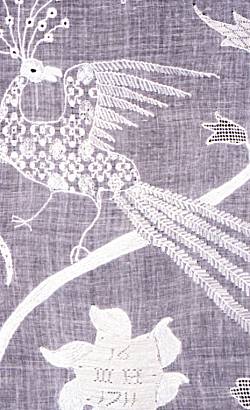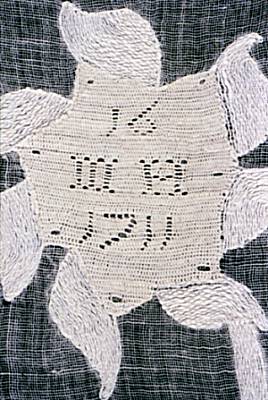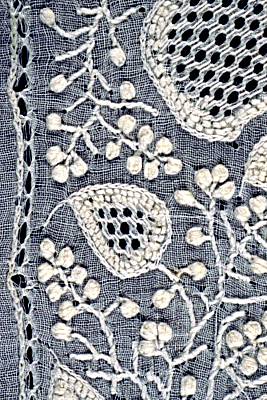
Detail from Apron, England, 1711

Close up with embroidered Date
.
| ANNE WANNER'S Textiles in History / publications |
| Swiss
Whitework Embroideries a paper, given at the CIETA meeting of 1989 in Chicago USA, by Anne Wanner-JeanRichard |
| page 1 of 5 next |
| Introduction |
| In the 18th and 19th
century there were several centres which produced
whitework embroideries. The textile collection of St.
Gallen has some pieces of these centres. Few of them are
dated. The earliest embroidery on cotton is an english
apron with the date of 1711. As for the
technique we find satin stitch, chainstitch, and drawn
work. In Bohemia Miroslava Ludvicova
describes three waves of development. Specially the
second, from 1830 to 1860 brought many
fine works. |
Still in 19th century
special caps were embroidered in
"bourbonnaises", France. There is
almost no literature on them, but there is an extremely
high number of examples in the collection of St. Gallen.
The lace stitch is very similar to the lace stitch used
in Switzerland. On the reverse side we note the
difference to swiss works. In France there is quite often
chainstitch which gives the effect of small dots on the
frontside. In the 19th c. whitework embroideries were made in Denmark (Hedebo), in Norway (Hardanger), in Ireland (Mountmellik) as well. Also of 19th century are the fine whitework embroideries with rich drawn work of Manila. Sandra Castro of Manila is writing a thesis of this kind of works: Several local fabrics made of vegetable fiber are usually identified as "grasscloth". New research work shows that 2 qualities can be distinguished: Pina means the cloth made from leaves of the pineapple plant. Nippis were exported specially to Spain. Primary sources say that this is a fine grade of cloth manufactured from plantain. With these fabrics it is possibel to make the finest drawnworks. In the last years of 19th century, swiss machine embroiderers imitated Manila work with the machines. |
Detail from Apron, England, 1711 |
Close up with embroidered Date . |
Whitework Embroidery, Saxony, 2nd half 18th c |
Baby dress for
Baptism, mid 19th c., |
|
to be used for a
French Cap, France, 19th c. |
Detail from
Headdress |
Detail of a Pina Cloth, Manila, end of 19th c. |
Manila
Embroidery, made in Switzerland |
 Chikan Embroidery, India, 2nd half 19th c. |
| Introduction | Swiss embroidery | Exhibitions | Historic Embroideries | 20th century | Literature |
| home content | Last revised 15 August, 2005 |